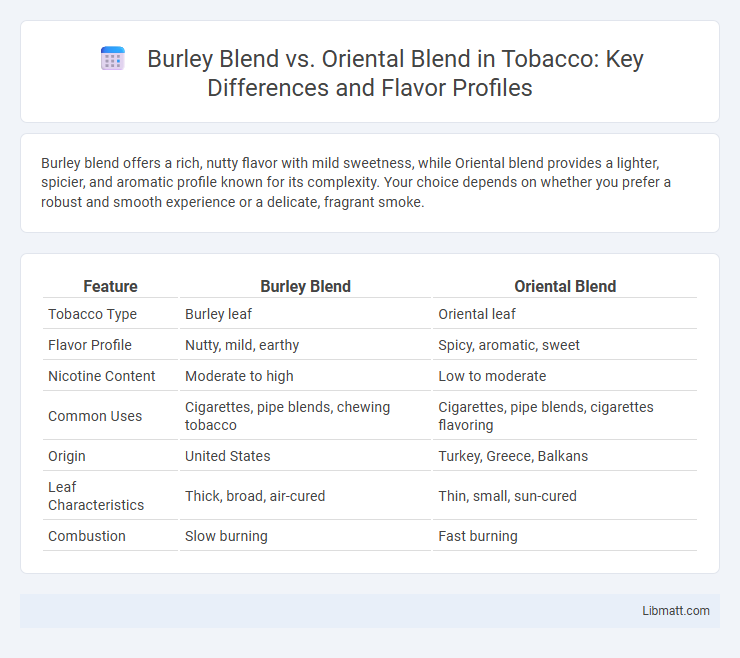Burley blend offers a rich, nutty flavor with mild sweetness, while Oriental blend provides a lighter, spicier, and aromatic profile known for its complexity. Your choice depends on whether you prefer a robust and smooth experience or a delicate, fragrant smoke.
Table of Comparison
| Feature | Burley Blend | Oriental Blend |
|---|---|---|
| Tobacco Type | Burley leaf | Oriental leaf |
| Flavor Profile | Nutty, mild, earthy | Spicy, aromatic, sweet |
| Nicotine Content | Moderate to high | Low to moderate |
| Common Uses | Cigarettes, pipe blends, chewing tobacco | Cigarettes, pipe blends, cigarettes flavoring |
| Origin | United States | Turkey, Greece, Balkans |
| Leaf Characteristics | Thick, broad, air-cured | Thin, small, sun-cured |
| Combustion | Slow burning | Fast burning |
Introduction to Burley and Oriental Tobacco Blends
Burley tobacco blends are known for their mild to medium strength and nutty, earthy flavor, often used in American-style cigarettes and pipe tobacco. Oriental tobacco blends, originating from Turkey and the Balkans, offer a lighter, aromatic, and spicy profile with a higher sugar content that enhances sweetness. Both blends serve distinct roles in tobacco products, with Burley providing body and depth, while Oriental adds complexity and fragrance.
Historical Origins of Burley and Oriental Blends
Burley tobacco originated in the United States during the 19th century, prized for its light air-cured process that produces a mild, nutty flavor ideal for cigarette and pipe blends. Oriental tobacco, cultivated mainly in the Balkans and Turkey, has ancient roots dating back to the Ottoman Empire, recognized for its small leaves and aromatic, spicy notes resulting from sun-cured methods. Understanding the historical origins of Burley and Oriental blends allows you to appreciate the distinct cultural and agricultural influences shaping their unique taste profiles.
Leaf Characteristics: Burley vs Oriental Tobacco
Burley tobacco leaves are air-cured, thick, and porous with a light brown color, offering a mild, nutty flavor ideal for cigarette and pipe blends. Oriental tobacco leaves are sun-cured, smaller, and thinner with a distinctive aromatic quality and spicy, sweet taste that enhances complexity in blends. The structural differences between Burley's dense texture and Oriental's delicate leaf contribute to their unique smoking profiles and blend applications.
Flavor Profiles: Comparing Burley and Oriental Blends
Burley blend tobacco features a nutty, earthy flavor with a mild sweetness and low natural sugar content, making it ideal for robust, rich smoking experiences. Oriental blend tobacco offers a distinctly spicy, aromatic profile with floral and citrus notes, characterized by its lighter body and higher sugar content. Comparing the two, Burley blends provide a mellow, hearty taste while Oriental blends deliver a more complex, vibrant flavor with a subtle sweetness and exotic aroma.
Growing Regions and Climate Influence
Burley blends primarily originate from the United States, especially Kentucky and Tennessee, where a temperate climate with well-drained soil supports the tobacco's mild, nutty flavor development. Oriental blends come from the Eastern Mediterranean, notably Turkey, Greece, and Bulgaria, benefiting from hot, dry summers and abundant sunlight that enhance their aromatic, spicy characteristics. The distinct growing regions and climate conditions significantly influence the tobacco's chemical composition, determining the unique flavor profiles of Burley and Oriental blends.
Processing Methods: Burley vs Oriental Tobacco
Burley tobacco undergoes air-curing, where leaves are hung in well-ventilated barns for several weeks, resulting in a light brown, dry leaf with low sugar content and a mild, nutty flavor profile. Oriental tobacco is sun-cured, involving exposure to direct sunlight for a shorter period, producing smaller, thinner leaves with a high sugar concentration and a distinctive aromatic, spicy taste. The distinct curing methods significantly influence the chemical composition, moisture levels, and flavor characteristics of Burley and Oriental tobacco blends.
Usage in Cigarette and Pipe Blends
Burley blend is commonly used in both cigarette and pipe blends due to its mild flavor and high nicotine content, offering a smooth and rich smoking experience. Oriental blend, characterized by its aromatic and spicy notes, is primarily favored in cigarette mixtures to enhance flavor complexity and improve combustion qualities. Tobacco manufacturers often combine Burley with Oriental tobaccos to balance strength and aroma, optimizing the overall smoking profile.
Health Considerations: Burley vs Oriental Tobacco
Burley tobacco contains higher nicotine levels compared to Oriental tobacco, which may contribute to increased addiction risk and greater health concerns. Oriental tobacco is generally lighter and lower in nicotine, potentially reducing the intensity of harmful effects associated with tobacco use. Both blends, however, contain carcinogenic compounds, making any tobacco consumption a significant health hazard.
Market Demand and Popularity Trends
Burley blend cigarettes maintain steady market demand due to their mild, nutty flavor and affordability, appealing to smokers seeking a smoother experience. Oriental blend cigarettes are gaining popularity in niche markets because of their aromatic, spicy character and association with premium, exotic tobacco varieties. Your choice may depend on preferences for either consistent, mainstream appeal with Burley blends or the increasing trend toward unique, flavorful Oriental blends.
Choosing the Right Blend: Burley or Oriental?
Burley blend offers a nutty, mild flavor with a slow burn, making it ideal for smokers who prefer a mellow experience and good moisture retention. Oriental blend provides a distinctive aromatic profile with spicy, floral notes due to its sun-cured leaves, appealing to those seeking a more complex and exotic taste. Your choice depends on whether you prioritize the smoothness and body of Burley or the vibrant, aromatic character of Oriental.
Burley blend vs Oriental blend Infographic

 libmatt.com
libmatt.com